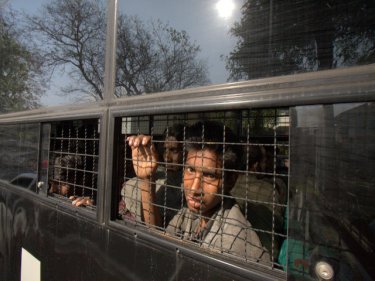 Human trafficking and people smuggling are both very serious crimes, happening every day and world-wide. These two terms tend to be mixed up or thought to be the same but human trafficking differs drastically from people smuggling.
Human trafficking and people smuggling are both very serious crimes, happening every day and world-wide. These two terms tend to be mixed up or thought to be the same but human trafficking differs drastically from people smuggling.Every day, many people are forced to leave their hometowns because of wars, high unemployment, religious persecution or poor living conditions. They are aiming to find a safer place with better living condition to live in. To be able to get to a wealthier country than their home country a significant amount of people hire smugglers to transport them to such a country illegally. After they arrived at their final destination, they are free and unattached to their former smugglers. Human smuggling is a crime to the state because it violates a state's immigration laws. Human trafficking, however, is a crime because it involves exploitation and compulsion. Usually, people are forced to be trafficked against their own will; which does not have to involve travel. Unlike people smuggling, human trafficking does not mean to transport a person. Instead, they are held as slaves and exploited for labour or sexual pleasure. As a result, human trafficking is a crime because it violates a person's rights and freedom. In other words, victims of human trafficking are not allowed to leave the place where they are stationed. In most cases, these victims receive a very low payment or even no payment at all for their efforts. The most two common forms of human trafficking are: bonded labor and forced labor.
Bonded labor, which is also referred to as debt bondage, is the most widely used method for enslaving people. Tied down to a strict contract or agreement, victims of bonded labor work as a means of repayment for borrowed money or service such as transport. The effort put into this repayment is frequently greater than the borrowed value.
On the basis of violence, forced labor demands people to work against their will and power. Whoever tries to escape or refuses to work is put under violent punishment. Examples for forced labor are agricultural labor, domestic service, sweatshop factory labor and in particular sexual exploitation. Approximately 80% of trafficking involves sexual exploitation and 19% involves labor exploitation. The estimated global profits made from all trafficked labor are US$ 31.6 Billion.
Child trafficking
Child exploitation is most commonly used for prostitution; also virtually. Other forms are child pornography, child labor, removal of organs, child soldiers, illegal adoption or for early marriage. Trafficked children mostly suffer from poverty and have been taken from the street or sold by their parents. An estimated 1.2 million children are trafficked each year.
Drug trafficking
This illegal transportation form uses the human body as container to smuggle illegal substances. These substances are swallowed or inserted into the body to transport Heroin, Kokain or other illegal drugs. The person aims to cross the border, excrete the substance and then sell it, get payed for the transportation or avoid violence by their drug dealers. An increasing method of transporting drugs is liquid-filled balloons or condoms. In any case, inserting drugs is a major risk for the human body.
Modern slavery - Human trafficking
The "4P" plan by the EU against human trafficking:
Shocking facts:
No comments:
Post a Comment